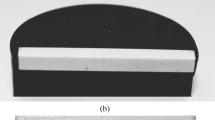On the basis of studying features of Al2O3–TiC-ceramic specimen edge morphology formation with flat diamond grinding the main forms and geometric parameters of chipping. A correlation is revealed for chipping parameters with grinding depth, and longitudinal and transverse feeds. An explanation is proposed for the significant effect of grinding regime and specimen edge orientation with respect to longitudinal and transverse feeds of the mill table on edge morphology.





Similar content being viewed by others
References
A. V. Lose, O. A. Loseva, and Yu. S. Dmitrevskaya, “Requirement for using finishing tecjhnology in engineering,” Metalloobrabotka, No. 1 (49), 209 (2010).
Li Kun and T. Warren Liao, “Surface/subsurface damage and the fracture strength of ground ceramics,” J. Mater. Proc. Tech., 57, 207 – 220 (1996).
V. V. Kuzin, “Technology for machining high-refractory ceramic parts based on silicon nitride,” Refract. Indust. Ceram., 47(4), 204 – 208 (2006).
T. El-Wardany, R. Barth, J. Holowczak, et al., “Optimum process parameters to produce green ceramic complex parts,” CIRP Annals — Manufacturing Technology, 58, 109 – 112 (2009).
V. Kuzin, “A model of forming the surface layer of ceramic parts based on silicon nitride in the grinding Process,” Key Eng. Mat. Precision Machining, 496, 127 – 131 (2012).
Xiaohu Liang, Bin Lin, Xuesong Han, and Shangong Chen, “Fractal analysis of engineering ceramics ground surface,” Appl. Surf. Sci., 258, 6406 – 6415 (2012).
V. V. Kuzin, “Increasing the operational stability of nitride-ceramic cutters by optimizing their grinding Conditions,” Russian Engin. Res., 23(12), 32 – 36 (2003).
I. L. Shkarupa and D. A. Klimov, “Machining of ceramic materials based on aluminum oxide, and silicon nitride and carbide,” Steklo. Keram., No. 6, 16 – 18 (2004).
V. V. Kuzin, “Technological aspects of diamond grinding of the nitride ceramics,” Russian Engin. Res., 24(1), 23 – 28 (2004).
V. A. Rogov and M. I. Shkarupa, “Comparative analysis of machining of ultrahard ceramic materials by grinding,” Tekhnol. Mashinostroeniya, No. 5(83), 12 – 116 (2009).
M. A. Volosova, “Study of the effect of combined surface treatment on physicomechanical properties of oxide and nitride cutting tool ceramic, “Al2O3–TiC ceramic specimens,” MGTU STANKIN, No. 2, 39 – 43 (2013).
M. Emami, M. H. Sadeghi, and Ahmed A. D. Sarhan, “Investigating the effects of liquid atomization and delivery parameters of minimum quantity lubrication on the grinding process of Al2O3 engineering ceramics,” J. Manufacturing Processes 15, 374 – 388 (2013).
J. Wang, P. Feng, J. Zhang, et al., “Modeling the dependency of edge chipping size on the material properties and cutting force for rotary ultrasonic drilling of brittle materials,” Internat. J. Machine Tools and Manufacture, 101, 18 – 27 (2016).
V. V. Kuzin, S. N. Grigor’ev, M. Yu. Fedorov, S. Yu. Fedorov, “Performance of channel cutters with ceramic plates in machining quenched steel,” Russian Engineering Research, 33(1), 24 – 28 (2013).
C. E. H. Ventura, J. Köhler, and B. Denkena, “Strategies for grinding of chamfers in cutting inserts,” Precision Engineering, 38, 749 – 758 (2014).
V. V. Kuzin, S. I. Dos’ko, V. F. Popov, et al., “Tooling for high-speed cutting,” Russian Engineering Research, 25(9), 20 – 25 (2005).
V. V. Kuzin, “Effective use of high density ceramic for manufacture of cutting and working tools,” Refract. Indust. Ceram., 51(6), 421 – 426 (2010).
V. V. Kuzin and S. Yu. Fedorov, “Correlation of diamond grinding regimes with Al2O3–TiC-ceramic surface condition,” Refract. Indust. Ceram., 57(5), 520 – 525 (2017).
V. V. Kuzin, S. N. Grigor’ev, and V. N. Ermolin, “Stress inhomogeneity in a ceramic surface layer under action of an external load. Part 1. Effect of complex mechanical loading,” Refract. Indust. Ceram., 54(5), 416 – 419 (2014).
V. V. Kuzin, S. N. Grigor’ev, and V. N. Ermolin, “Stress inhomogeneity in a ceramic surface layer under action of an external load. Part 2. Effect of thermal loading,” Refract. Indust. Ceram., 54(6), 497 – 501 (2014).
V. V. Kuzin, M. R. Portnoi, and S. Yu. Fedorov, “Stress inhomogeneity in oxide-carbide ceramic surface with developed relief under action of heat flow,” Refract. Indust. Ceram., 56(5), 557 – 560 (2016).
V. Kuzin, S. Grigoriev, and M. Portnoy, “Effect of thermal loading on stresses in defective surface layer of ceramics,” Appl. Mechan. Mater., 827, 189 – 192 2016.
V. V. Kuzin, S. N. Grigor’ev, and V. N. Ermolin, “Stress inhomogeneity in a ceramic surface layer under action of an external load. Part 4. Combined effect of force and thermal loads,” Refract. Indust. Ceram., 55(1), 40 – 444 (2014).
The present work is supported by the Russian Federation Ministry of Education and Science within the scope of a state assignment for MGTU STANKIN in the sphere of scientific activity (project registration number 9.1372.2017).
Author information
Authors and Affiliations
Corresponding author
Additional information
Translated from Novye Ogneupory, No. 5, pp. 63 – 67, May, 2017.
Rights and permissions
About this article
Cite this article
Kuzin, V.V., Fedorov, S.Y. & Grigor’ev, S.N. Features of Al2O3–TiC-Ceramic Specimen Edge Morphology Formation During Diamond Grinding. Refract Ind Ceram 58, 319–323 (2017). https://doi.org/10.1007/s11148-017-0103-2
Received:
Published:
Issue Date:
DOI: https://doi.org/10.1007/s11148-017-0103-2




